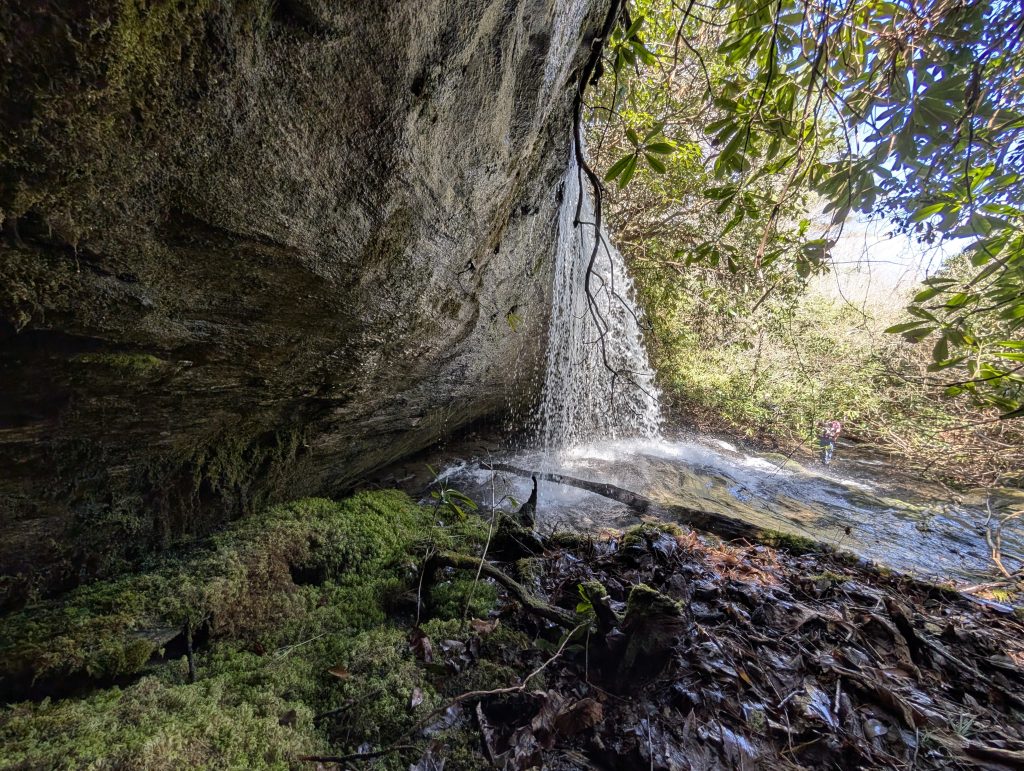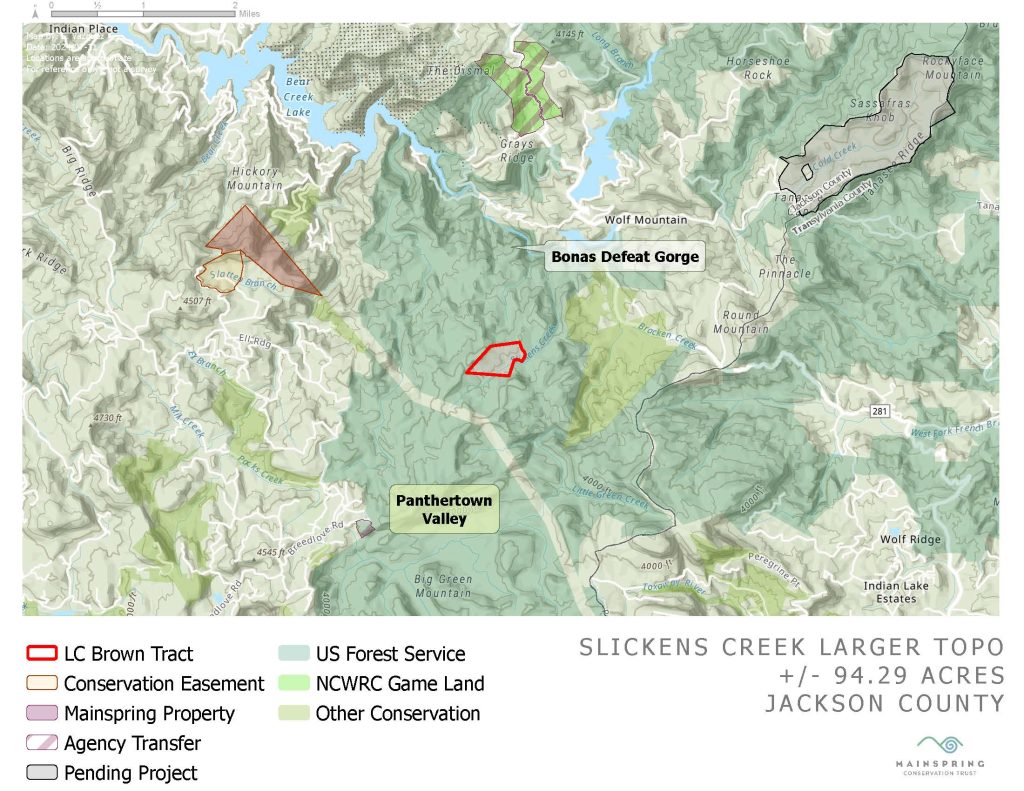Read our annual fall publication on PDF by clicking here.

Stewards of the Southern Blue Ridge
Thanks to a collaboration among local conservation partners, Mainspring Conservation Trust has acquired a critical 94-acre inholding within Panthertown Valley, and is now on track to be permanently protected.
One of western North Carolina’s most cherished natural areas, Panthertown is often called the “Yosemite of the East.” The 6,300 acres stretch along the Eastern Continental Divide, offering more than 25 miles of trails that wind through granite domes, mountain bogs, trout streams, and waterfalls.

When the U.S. Forest Service acquired Panthertown Valley and the surrounding Roy Taylor Memorial Forest in the 1980s, one parcel—now known as the Slickens Creek tract—remained privately owned. Surrounded entirely by national forest, the property includes more than 2,800 feet of wild trout waters and provides critical early successional habitat for species such as Golden-winged Warblers and Ruffed Grouse. The tract also lies within the Blue Ridge Parkway viewshed and links two popular trails: the Rattlesnake Knob and Turkey Knob trails.
Conserving this inholding has been a shared goal of Mainspring, Friends of Panthertown, Highlands-Cashiers Land Trust, and the U.S. Forest Service for decades. The opportunity finally arrived when the longtime owners’ heirs prepared to sell. Thanks to support from a private donor and Atira Conservation, Mainspring was able to move quickly to secure the land before it could be lost to private development.

“Protecting the Slickens Creek property is about more than conserving acreage—it’s about completing the vision for Panthertown Valley,” said Sophie Vaszquez, Land Conservation Associate at Mainspring Conservation Trust. “This project connects trails, protects rare habitats, and ensures that this wild landscape will remain unspoiled for generations to come.”
Generous donors to the partnering organizations, including the Community Foundation of Western North Carolina, have helped us raise $100,000 of the $150,000 needed to remove unsafe structures, create a new trail connection to the Panthertown network, and support the long-term stewardship of the site’s sensitive habitats. If you’d like to help with the remaining $50,000 needed, visit here and apply your donation to “Panthertown Land Purchase” in the drop-down menu.
The Slickens Creek acquisition builds on other conservation projects with the land trust and Panthertown. In 2017, Mainspring purchased a 15.9-acre tract at the Salt Rock Gap trailhead—transforming a pinch point into a welcoming public entrance before transferring it to the Forest Service.
As the final unconserved piece of this significant landscape, this latest Mainspring project links ecological protection with recreation and beauty. It’s the culmination of decades of persistence and partnership, and a great example that when preparation meets opportunity, this region wins.
Click here to support this conservation project.
When Sylva resident Jeremy Hyatt looks across the landscape of western North Carolina, he doesn’t just see beautiful scenery — he sees his childhood.

“These places are where I grew up — the rivers and streams I played in as a child with my brother and my cousins, the trails where I rode mountain bikes, and the woods I camped in,” Hyatt said. “They still are.”
Now, Hyatt is turning that lifelong connection into action as the new Executive Director of Mainspring Conservation Trust. A lifelong resident of western North Carolina and a Tribal citizen of the Eastern Band of Cherokee Indians (EBCI), Hyatt steps into the role to lead the nonprofit, which has worked since 1997 to conserve the special places in the heart of the Southern Blue Ridge for the benefit of all.
Hyatt’s leadership is backed by more than 15 years of experience guiding large-scale initiatives across government, natural resources, and cultural preservation. During his 14-year tenure with the EBCI, he served as Secretary of Operations, overseeing 17 programs and 400 employees while managing an $80 million budget. In that role, he spearheaded critical infrastructure and recreation projects, including the Fire Mountain Trails and Fire Mountain Disc Golf Sanctuary. Other roles within the Tribe and later, with the Museum of the Cherokee People, further shaped his ability to build partnerships and connect with people.
From the beginning of the search process, Hyatt’s qualities were clear. “Jeremy demonstrated a combination of vision, experience, and deep regional connection that immediately stood out,” said James Stork, Mainspring board member and chair of the Search Committee. “We were particularly impressed by his ability to build partnerships across tribal, public, private, and nonprofit sectors, and his proven success leading large-scale operations. Just as important, though, was Jeremy’s deep-rooted passion for Western North Carolina and his thoughtful, collaborative approach to community engagement.”
In his first few months, Hyatt plans to listen and learn, connecting with staff, board members, partners, community stakeholders, and funders to understand where his leadership can best serve Mainspring’s next chapter. “Conservation must be collaborative,” he said. “It must be anchored in the needs of rural communities, Indigenous voices, working lands, and the integrity of our natural systems. Listening to others will allow me to identify where I can best add value without disrupting the great success Mainspring has achieved and continues to build upon.”
The board hopes Hyatt’s leadership will bring both continuity and new energy. “With Jeremy’s experience managing complex initiatives and engaging diverse stakeholders, we believe he will strengthen Mainspring’s role as a regional conservation leader,” Stork said. “We hope his leadership will bring expanded opportunities for partnership, increased public engagement in our work, and creative approaches to land and water protection that reflect both environmental and cultural priorities.”
For Hyatt, the work is both professional and personal. “I consider myself of this place, so it’s incredible to be able to work with an organization that affirms that we are all responsible for the stewardship of our environment, cultural heritages, histories, and community ecologies,” he said. “I am looking forward to joining this talented team to make a positive difference for my family, my community, and my region.”
Stork said the board feels the same. “This decision was made with great care and intention. Jeremy’s appointment reflects our belief that conservation is not just about protecting land and water—it’s about people, place, and heritage. We invite the community to join us in welcoming him and look forward to all we will accomplish together under his leadership.”
Founded in 1997, Mainspring has conserved thousands of acres of land and working farms, along with miles of streams and riverbanks in the Southern Blue Ridge. With offices in Franklin and Andrews, the nonprofit partners with landowners, agencies, and communities to protect the region’s natural and cultural heritage. To learn more, visit www.mainspringconserves.org.